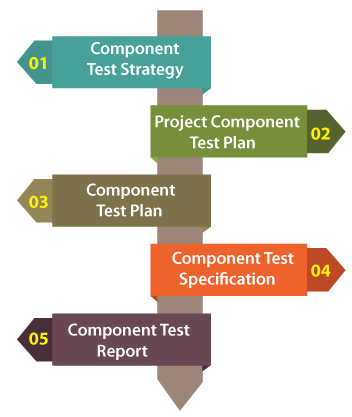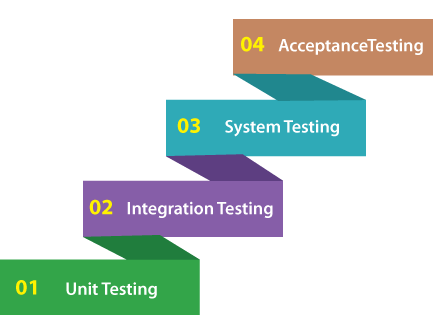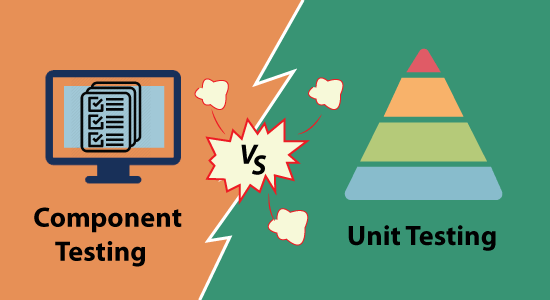In this section, we are going to discuss the difference between component testing and Unit testing based on the various parameters.
As we understood in the earlier section of software testing, all types of software testing have their features and functionality in order to test the application or software.
Before getting into the difference between component testing and unit testing, we will briefly introduce Component and Unit testing.
What is Component Testing?
It is one of the essential types of software testing in which the accessibility of each component is verified.
It can be implemented individually, that is, the separation from the remaining system. However, it has relied on the model of the preferred life cycle.
The execution of components testing makes sure that all the application component is working correctly and according to the requirements.
In order to execute the component testing, all the components or modules require to be in the individual and manageable state. And all the related components of the software should be user-understandable.
As we can see in the following image of the component testing process:

It is executed by the developers, where they should perform component testing before they move on to develop another component.
Once the identification of the defects happens in component testing, either the developer can fix all of them before moving to another component, or he/she can substitute between the fixing and development alternatively.
For more information about Component Testing, refers to the following link:
What is Unit Testing?
It is also a part of software testing and is used whenever the application is ready and given to the Test engineer. He/she will start checking every module of the application independently or one by one. This process is known as Unit testing.

In unit testing, the term unit is a single testable part of a software system and it is tested during the development stage of the application.
Unit testing is a testing method that tests all the independent modules to verify if there is an issue by the developer himself. It is correlated with the functional correctness of the independent modules.
The key differences between Component Testing and Unit Testing
The critical difference between both testings is that the test engineers implement the Component Testing whereas the developers or SDET experts implement the Unit Testing.
Let's understand some other key differences between Component Testing and Unit testing:
- Component Testingis executed at the application level; on the other hand; Unit Testing is executed at a granular level.
- Component Testingis a type of black-box testing, whereas Unit Testing is part of the white box testing.
- In Component testing, all the modules/ components of the related software are checked individually with or without segregation with other objects or modules of the system. On the other hand, Unit Testing is tested if a separate program or code is getting performed according to the particular requirements.
- In Component Testing, testing is performed by validating use cases and test requirements, while in Unit Testing, we will test the application in contradiction of the design documents.
- When we performed Component Testing, the test engineer does not become aware of the internal planning of the software. Whereas, when we performed the Unit Testing, the developers aware of the internal planning of the software.
Component Testing VS Unit Testing
Let us see the following comparison table to understand the essential differences between Component Testing and Unit Testing.

|
S.NO. |
Comparison Basis |
Component Testing |
Unit Testing |
|
1. |
Definition |
It includes testing
each component/module of the software individually. |
It includes testing
of separate modules for program implementation. |
|
2. |
Validates |
Component testing
tests the use cases and test specifications. |
Unit testing is
validating in contradiction of design documents. |
|
3. |
Executed by |
Component testing
executed by the team of test engineers. |
The team of
Developers executes unit testing. |
|
4. |
Performed |
Once the Unit
testing is successfully implemented, then only we will be performing the
Component testing. |
Unit testing is
implemented before the execution of Component testing. |
|
5. |
Internal planning |
In Component
testing, the test engineer does not know about the internal planning of the
application. |
In Unit testing, the
test engineer is aware of the internal planning or design of the application
or the software. |
|
6. |
Execution level |
Component testing is
performed at the application level. |
It is performed at a
granular level. |
|
7. |
Type of |
It is a part of
black-box testing. |
It is part of the
white- box testing. |
|
8. |
Error Detection |
In Component
testing, the error detection is a bit complex as compared to unit testing. |
In Unit testing, the
detection of errors is easy as compared to component testing. |
|
9. |
Only implemented |
Component testing is
only executed when the entire software is developed. |
Unit testing is only
implemented after every development step. |
Conclusion
After seeing all the essential differences between Component Testing and
Unit testing, we can conclude that
component testing is quite similar to unit testing. Still, it is performed at a
higher level of integration and in the application setting, not just in the
context of that unit/program as in unit testing.
Once the unit testing is implemented successfully, then only we
can execute the Component testing.
In Component Testing, the error identification is a bit challenging; on the other hand, Unit Testing is performed after each development
process. Therefore, in-unit testing error identification is a bit easy as
compared to component testing.
If the Component testing is performed appropriately, then there
are fewer bugs in the next stage; thus, it is conducted before unit testing,
assessing the programs.
At last, we can say that component testing is essential for
finding the errors and bugs to ensure that each component of an application
works resourcefully. And it is always suggested to carry out the component test
before proceeding with the unit testing.



0 Comments